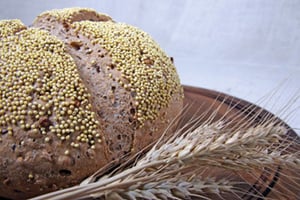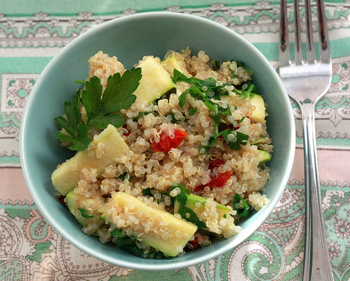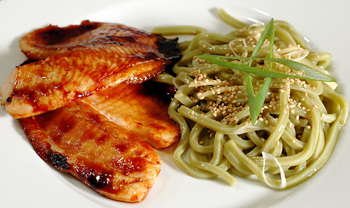I attended a seminar which revolved around our shifting culture and how that manipulates the health and wellness needs of Americans at the Academy of Nutrition and Dietetics Food and Nutrition Conference and Expo. I was also enlightened to many interesting statistics through the 2012 Food and Health Survey produced by the International Food Information Council Foundation (IFIC). Let me share some of these interesting stats with you.
Physical Activity
- 77% of Americans do not meet the US Department of Health and Human Services Physical Activity Guidelines
- 34% of Americans are sedentary
Body Weight
- 33% of Americans 20 years and older are overweight (and not obese) (CDC 2009-2010)
- 35.9 % of Americans 20 years and older are obese (CDC 2009-2010)
- 18.4% of adolescents age 12-19 years are obese (CDC 2009-2010)
- 18% of children age 6-11 years are obese (CDC 2009-2010)
- 12.1% of children age 2-5 years are obese (CDC 2009-2010)
- 55% of Americans are trying to lose weight
Americans Concerns and Thoughts on Their Health
- Cardiovascular Disease, Weight, Cancer, Physical Activity, and Healthy Eating are American’s largest concerns
- 67% of consumers feel they have a great amount of control over their health
- 73% feel food greatly affects their health

Views of Making Changes to Dietary Habits
- 66% of people consider health when purchasing their food
- 75% are trying to improve whole grain intake
- 78% are trying to cut calories by drinking water, low, and no calorie beverages
- 87% of people are trying to eat more fruits and vegetables
- 48% of people think it is easier to do their taxes than to eat right (assessed in April 2012)
Americans understand there are risks associated with poor diet and physical activity; in fact, according to the survey these risks are some of American’s largest concerns. We understand that risk for these diseases is partially in our control and that food is a major factor in controlling disease risk.
It is also important to note that physical activity is just as important as dietary intake is on health. This survey has also disclosed that people are starting to make changes in their diet (yahoo!) but it is also evident that close to half of Americans find that trying to eat a healthy diet is a tedious task.
So let’s make it simple so we can make some lifelong changes.
A healthy 2,000 calorie diet would ideally be comprised of:
Grains: 6-8 ounce equivalents per day (make at least half of them whole!)
- 1 oz= 1/2 of a 2 oz slice of Great Harvest bread, 1 cup of dry cereal, ½ cup cooked rice, pasta, or cooked cereal, 1 corn or flour tortilla (6’’), 1 pancake (5’’), ¼ large bagel, 1 small biscuit (2’’), 5 whole wheat crackers, ½ muffin, 3 cups popped pop corn

Vegetables: 2 ½ - 3 cups per day (fresh, frozen, or canned)
- 1 cup = 1 cup of 100% vegetable juice, raw or cooked vegetables; 2 cups of leafy greens
Fruit: 1 ½ -2 cups per day (fresh, frozen, or canned)
- 1 cup = 1 cup of 100% juice, raw or cooked fruit (ex. applesauce); 1 apple, orange, banana; or ½ cup dried fruit
Dairy: 3 cups per day (Choose fat free versions)
- 1 cup= 1 cup milk, fortified soy milk, pudding, frozen or regular yogurt, 1 ½ cup ice cream, ½ cup evaporated milk,1 ½ oz (~2 slices) hard cheese, 2 oz (~2 slices) processed cheese, 2 cups cottage cheese, ½ cup ricotta cheese, 1/3 cup shredded cheese

Protein: 5-6 ½ ounce equivalents per day (Grill, bake, or broil to limit added fat and calories and choose fish twice a week)
- 3 oz. meat, fish or poultry = deck of cards
- 3 oz. grilled/baked fish = checkbook
- 2 Tbsp. peanut butter = ping pong ball
*Visit http://www.myplate.gov/ to find your individualized plan or consult with a Registered Dietitian if you have more specialized needs or dietary restrictions.
Enjoy meals and snacks with these components, and you’ll most likely find you are meeting all of your nutrient and calorie needs. Use your body weight as a gauge of excessive calorie intake. Listen to your internal hunger cues for guidance on when and how much to eat…are you eating to nourish yourself or are you eating to satisfy a craving or entertain boredom? Your stomach is about the size of your fist so don’t go overboard on the amount of food you serve yourself either. If you are eating due to boredom, stick with fresh fruits and veggies to boost your antioxidant, micronutrient, and fiber intake.
Here's to Healthy Holidays!
Share this on Facebook with this linkor use the share buttons at the top of the post.
References:
FastStats. Centers for Disease Control and Prevention. 10 October 2012. December 2012 <http://www.cdc.gov/nchs/fastats/overwt.htm>.
International Food Information Council Foundation. 2012 Food and Health Survey: Consumer Attitudes Toward Food Safety, Nutrition & Health. May 2012.
Shah P and Smith-Edge M. Tomorrow’s Culture Shock: What it Means for Health and Wellness. Academy of Nutrition and Dietetics Food and Nutrition Conference and Expo. Pennsylvania Convention Center, Philadelphia, PA. 7 Oct 2012. Conference Presentation.
Quinoa and zucchini dish photo credit: SweetOnVeg via photopin cc
Fish and pasta photo credit: ilmungo via photopin cc



